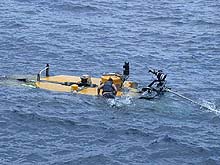
Recovering the Clelia during a dive earlier in the South Atlantic Bight mission. Note the swimmer and the cable attached to the mother ship. High seas such as those experienced today would jeopardize safe launch and recovery for those in the water as well as on the ship. Click image for larger view.
Mission to the Monitor: Word from the Field
September 13, 2001
John McDonough
Islands in the Stream Project Coordinator
The Seward Johnson II departed Morehead City, NC, yesterday evening with Jeff Johnston and Tane Casserly from the Monitor National Marine Sanctuary aboard. The plan was to arrive on site just before sunrise, pick up three additional passengers from a shuttle boat, then conduct two dives. The first objective was to place a transponder, also known as a "pinger," on the wreck to ground truth the coordinates on a scale image of the Monitor in a geographic information system. The second was to conduct a video survey of the wreck, concentrating on the area of the gun turret, which is the next major artifact scheduled for recovery. If all went well, we intended to have a snorkeler in the water when the Clelia was launched to capture high-definition video of the submersible as it descended to the wreck. Unfortunately, as often happens at sea, things did not go as planned.
Upon arriving on the bridge before dawn with the first steaming cup of coffee of the day, I was greeted by winds gusting to 25 knots, whitecaps, and a significant rolling swell. Mike, the first mate on watch, estimated the height of the swells as 8-10 ft, but mentioned that the swells also had a 2-ft chop on top. Apparently, the two Category II hurricanes (Erin and Gabriele) in the Atlantic, although well east of our position, were enough to "kick things up a bit." While the Seward Johnson II is a very stable platform and makes for a comfortable ride under these conditions, launching a submersible is out of the question. So, after transferring one person from a small shuttle boat to the ship, we began to play a waiting game.
The weather refused to cooperate. It seemed that when the wind slacked, the swells increased. Then, when the swells decreased, the wind increased. At times, a mountain of water at least 12 ft high would come rolling slowly toward the stern of the vessel, lifting it up, over, and down the backside. Often, smaller waves and wavelets from unpredictable directions went racing by on the face of these mountains, foaming and churning. The end result was what is termed "confused seas." These conditions are the worst for launching and recovering a submersible, since timing is critical to the operation. Confused seas are unpredictable, and difficult to time. Imagine a vehicle, about one-quarter the size of a train boxcar, suspended from a swinging cable over heaving seas, and you can appreciate that caution is critical! Thus, the day ended with no submersible dives.
Sign up for the Ocean Explorer E-mail Update List.











































